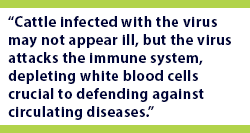
Veterinarian’s Corner: The BVD We Face Today
 By Dr. Curt Vlietstra, Boehringer Ingelheim senior professional services veterinarian
By Dr. Curt Vlietstra, Boehringer Ingelheim senior professional services veterinarianBovine Viral Diarrhea disease was first identified in North America in the 1940s. A variety of disease symptoms were seen in infected cattle, from ulcers throughout the gastrointestinal tract leading to hemorrhage and diarrhea, to respiratory disease and reproductive loss and the creation of chronic carriers known to be “persistently infected.” In the late 1950s, a virus now known as BVDV was found to be the causative agent and was first cultured for use in a vaccine in 1960. Since its discovery, BVDV has been associated with disease, ranging from devastating illness and acute deaths to hidden reproductive and performance losses.
As diagnostic technologies evolved, so did our understanding of BVDV. Those early, infamous accounts of BVDV infections are more closely associated with subtypes of BVDV we now know as Types 1a and 2a. They are also known as “cytopathic,” meaning they kill the host cells during the infection. Not surprisingly, these types of BVDV are incorporated into all modern cattle vaccines containing BVDV.
So why the walk down memory lane? This history and brief immunology lesson is important to understand as we talk about managing modern BVDV. Currently, approximately 70% of BVDV isolates that are tested are identified as Type 1b. They are also most commonly “non-cytopathic,” meaning they do not kill host cells and can persist and replicate inside the host—potentially indefinitely—and may lead to more shedding of the virus over time.
 The hallmark of modern BVDV, especially those where Type 1b is found, is immunosuppression. Cattle infected with the virus may not appear ill, but the virus attacks the immune system, depleting white blood cells crucial to defending against circulating diseases. Breeding animals may be sub-fertile without abortions. Growing calves may respond poorly to vaccines or antibiotics. Pounds are stolen and time is wasted.
The hallmark of modern BVDV, especially those where Type 1b is found, is immunosuppression. Cattle infected with the virus may not appear ill, but the virus attacks the immune system, depleting white blood cells crucial to defending against circulating diseases. Breeding animals may be sub-fertile without abortions. Growing calves may respond poorly to vaccines or antibiotics. Pounds are stolen and time is wasted.
While no currently marketed modified-live viral vaccines contain BVDV Type 1b, some have more modern Type 1a and 2a strains that may cross-protect better than other vaccines. All vaccines should provide some degree of cross-protection, but only if they are administered.
I often see that BVDV vaccination is delayed until well after cattle are weaned, shipped and/or comingled. This is puzzling to me, particularly given the investment that we have in youngstock and how common it has become to have calves raised offsite, often with calves from other farms. In visiting with veterinarians and producers, I believe the reasons for delaying vaccination fall into three categories:
- BVD isn’t the bold disease that it once was. For example, many farms screen for PI (persistently infected) calves and feel that little-to-no PI calves means they do not have BVDV on their farms.
- Farms have increased use and reliance on intranasal viral vaccines. These may do a good job of protecting against other causes of viral cattle diseases, but currently none of them contain BVDV.
- Some farmers believe maternal (colostrum) antibodies render BVDV vaccination useless until calves are several months old.
Having a good relationship with a herd veterinarian as well as knowledgeable calf specialists is important to help manage modern BVDV and to understand which, if any, of these reasons apply to any given farm. The risk factors for BVDV are similar to those of many other disease-causing pathogens, and understanding these risks is not necessarily straightforward. Even if changing vaccines or vaccine timing could help, no disease mitigation strategy can rely solely on vaccines. Other management factors should be discussed, reviewed and implemented. That said, marginalizing BVDV because it’s not as obvious as it once was is both unwise and unnecessary.
| Category: |
Animal health Starting Strong - Calf Care |

